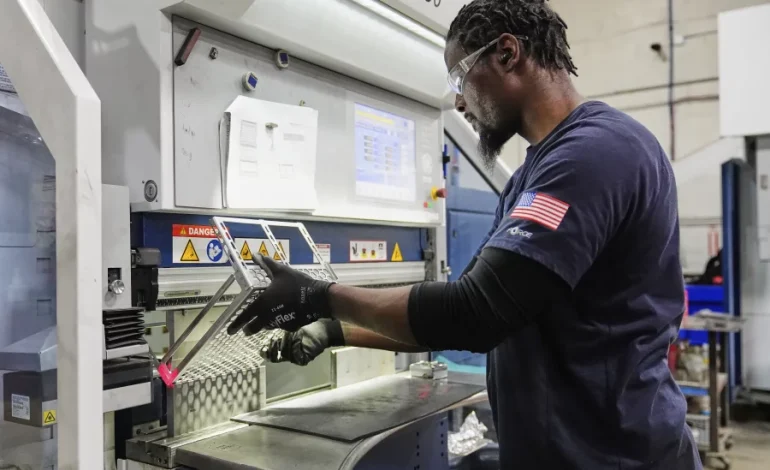Manufacturing jobs often receive a level of political and public attention that far exceeds their share of the modern American workforce, NPR reports.
Leaders across the political spectrum frequently champion policies aimed at reviving the sector. But what exactly makes manufacturing “special,” if anything? Is this focus grounded in economic logic, or is it a nostalgic holdover from a different era?
To explore this question, Planet Money analyzed a broad range of data and economic studies, including input from leading economists and Nobel Prize winners. Our aim: to understand whether manufacturing is indeed uniquely beneficial — not just politically, but economically — especially for workers.
There’s evidence that manufacturing jobs tend to pay better than many other sectors, especially for workers without a college degree. This advantage is often referred to as the “manufacturing premium.” While some studies argue the premium has declined, a comprehensive and recent study by economists David Card, Jesse Rothstein, and Moises Yi suggests the premium is still substantial.
Tracking over 100 million workers as they moved between industries, the researchers controlled for education, age, and experience — as well as harder-to-measure factors like work ethic and resilience. Their findings? Workers who transition from restaurant jobs to manufacturing see, on average, a 35% pay increase.
That premium surpasses what one would earn jumping into retail (11%), health care (19%), construction (25%), or even finance (32%). It’s not the highest among all sectors — oil and gas, for example, offer a 62% premium — but manufacturing remains among the top performers, especially in its more advanced segments.
The pay bump isn’t consistent across all manufacturing subsectors. For instance:
Low-premium sectors: Apparel (15%), furniture (19%)
Mid-tier: Plastics (30%), food products (32%)
High-end: Electronics (42%), transportation equipment (43%), chemicals (47%), petroleum and coal (62%)
In short, manufacturing is not monolithic. Advanced manufacturing, which often involves working with expensive machinery, delivers far greater rewards.
Economists offer several theories for why manufacturing jobs pay more:
Unionization: Historically, manufacturing has had stronger union presence, which often led to better wages. Though unionization rates have declined (7.9% in 2023), the legacy effects and occasional strongholds still matter.
Skill requirements: Manufacturing often requires on-the-job learning, particularly in more technical fields. This investment in skill development may prompt employers to offer better pay to reduce turnover.
Capital intensity: Workers in manufacturing often operate expensive equipment. Employers are likely to pay more to attract and retain reliable employees who won’t damage machinery or disrupt production.
Productivity: Factories tend to be more capital-intensive and technologically advanced, translating into higher worker productivity — and often, higher wages.
Interestingly, despite these pay incentives, many workers still avoid manufacturing jobs. Surveys indicate that many view factory work as physically demanding, rigid in scheduling, and at times uncomfortable. In 2024, Gallup found only 23% of manufacturing workers felt engaged at work — below the overall average.
A broader study by economists Gordon Hanson and Enrico Moretti examined where “good jobs” — defined as high-paying roles accessible to those without a college degree — come from. In 1980, nearly 40% of such jobs were in manufacturing. That figure has dropped sharply due to automation and offshoring, but manufacturing still accounts for about 20% of all good jobs today, despite employing only 10% of the workforce.
This disproportionate contribution supports the idea that manufacturing continues to play an outsized role in offering upward mobility, particularly for non-college-educated workers. However, many of today’s good jobs are shifting toward sectors like tech, finance, and healthcare — which often require advanced degrees.
So, does this justify aggressive government efforts to revive manufacturing?
It’s complicated. While some believe tariffs or subsidies might revive certain sectors, many economists remain skeptical. Some jobs — particularly in low-end manufacturing — are unlikely to return, and protectionist policies could raise consumer prices and hurt other parts of the economy.
Instead, many experts suggest focusing on workforce development: vocational education, community college training, and apprenticeships. These can help workers — especially those without a four-year degree — gain skills needed in both manufacturing and other high-potential sectors.
Moreover, if the goal is to replicate manufacturing’s strengths, policymakers might explore ways to make service-sector jobs better, such as improving wages, encouraging unionization, or investing in capital-intensive service industries that still offer pathways for advancement.










The latest news in your social feeds
Subscribe to our social media platforms to stay tuned